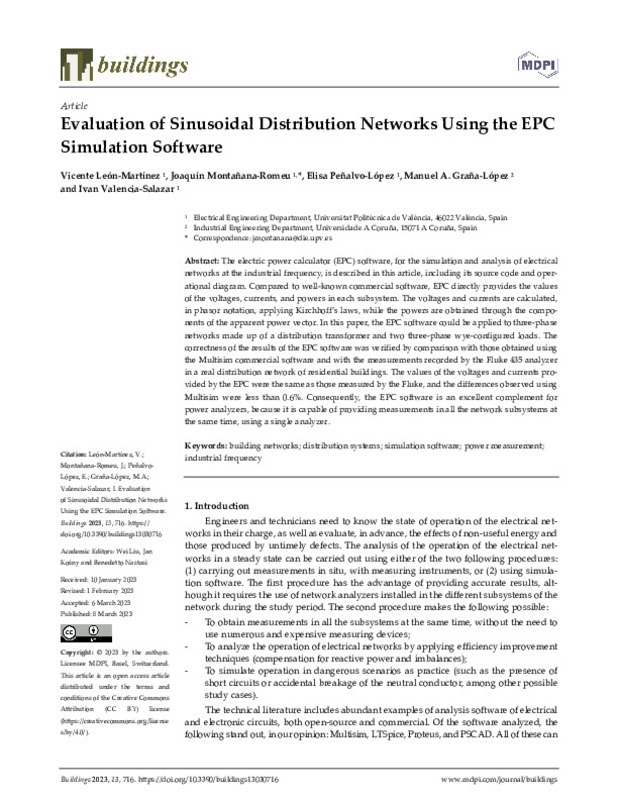JavaScript is disabled for your browser. Some features of this site may not work without it.
Buscar en RiuNet
Listar
Mi cuenta
Estadísticas
Ayuda RiuNet
Admin. UPV
Evaluation of Sinusoidal Distribution Networks Using the EPC Simulation Software
Mostrar el registro sencillo del ítem
Ficheros en el ítem
| dc.contributor.author | León-Martínez, Vicente
|
es_ES |
| dc.contributor.author | Montañana-Romeu, Joaquín
|
es_ES |
| dc.contributor.author | Peñalvo-López, Elisa
|
es_ES |
| dc.contributor.author | MANUEL ANGEL GRAÑA LOPEZ
|
es_ES |
| dc.contributor.author | IVAN VALENCIA SALAZAR
|
es_ES |
| dc.date.accessioned | 2023-05-12T18:01:56Z | |
| dc.date.available | 2023-05-12T18:01:56Z | |
| dc.date.issued | 2023-03 | es_ES |
| dc.identifier.issn | 2075-5309 | es_ES |
| dc.identifier.uri | http://hdl.handle.net/10251/193319 | |
| dc.description.abstract | [EN] The electric power calculator (EPC) software, for the simulation and analysis of electrical networks at the industrial frequency, is described in this article, including its source code and operational diagram. Compared to well-known commercial software, EPC directly provides the values of the voltages, currents, and powers in each subsystem. The voltages and currents are calculated, in phasor notation, applying Kirchhoff's laws, while the powers are obtained through the components of the apparent power vector. In this paper, the EPC software could be applied to three-phase networks made up of a distribution transformer and two three-phase wye-configured loads. The correctness of the results of the EPC software was verified by comparison with those obtained using the Multisim commercial software and with the measurements recorded by the Fluke 435 analyzer in a real distribution network of residential buildings. The values of the voltages and currents provided by the EPC were the same as those measured by the Fluke, and the differences observed using Multisim were less than 0.6%. Consequently, the EPC software is an excellent complement for power analyzers, because it is capable of providing measurements in all the network subsystems at the same time, using a single analyzer. | es_ES |
| dc.description.sponsorship | This research was funded by Generalitat Valenciana, grant number GV/2021/149. | es_ES |
| dc.language | Inglés | es_ES |
| dc.publisher | MDPI AG | es_ES |
| dc.relation.ispartof | Buildings | es_ES |
| dc.rights | Reconocimiento (by) | es_ES |
| dc.subject | Building networks | es_ES |
| dc.subject | Distribution systems | es_ES |
| dc.subject | Simulation software | es_ES |
| dc.subject | Power measurement | es_ES |
| dc.subject | Industrial frequency | es_ES |
| dc.subject.classification | INGENIERIA ELECTRICA | es_ES |
| dc.title | Evaluation of Sinusoidal Distribution Networks Using the EPC Simulation Software | es_ES |
| dc.type | Artículo | es_ES |
| dc.identifier.doi | 10.3390/buildings13030716 | es_ES |
| dc.relation.projectID | info:eu-repo/grantAgreement/GENERALITAT VALENCIANA//GV%2F2021%2F149//DESARROLLO DE HERRAMIENTAS PARA LA DECARBONIZACIÓN DEL MUNICIPIO DE VINALESA/ | es_ES |
| dc.rights.accessRights | Abierto | es_ES |
| dc.contributor.affiliation | Universitat Politècnica de València. Escuela Técnica Superior de Ingeniería del Diseño - Escola Tècnica Superior d'Enginyeria del Disseny | es_ES |
| dc.description.bibliographicCitation | León-Martínez, V.; Montañana-Romeu, J.; Peñalvo-López, E.; MANUEL ANGEL GRAÑA LOPEZ; IVAN VALENCIA SALAZAR (2023). Evaluation of Sinusoidal Distribution Networks Using the EPC Simulation Software. Buildings. 13(3):1-22. https://doi.org/10.3390/buildings13030716 | es_ES |
| dc.description.accrualMethod | S | es_ES |
| dc.relation.publisherversion | https://doi.org/10.3390/buildings13030716 | es_ES |
| dc.description.upvformatpinicio | 1 | es_ES |
| dc.description.upvformatpfin | 22 | es_ES |
| dc.type.version | info:eu-repo/semantics/publishedVersion | es_ES |
| dc.description.volume | 13 | es_ES |
| dc.description.issue | 3 | es_ES |
| dc.relation.pasarela | S\485052 | es_ES |
| dc.contributor.funder | GENERALITAT VALENCIANA | es_ES |
| dc.contributor.funder | Universitat Politècnica de València |








